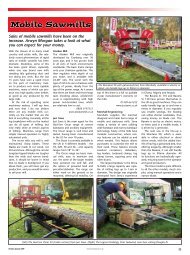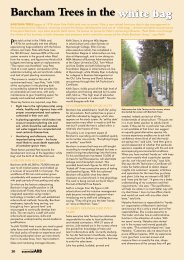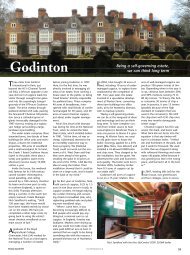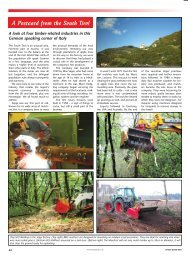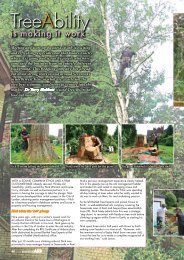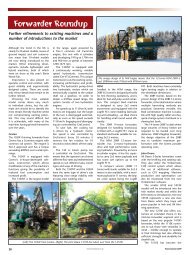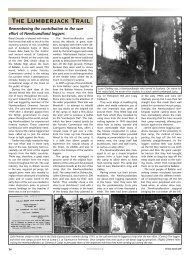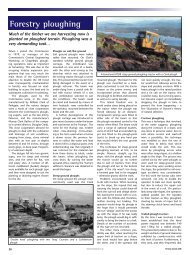Phytophthora Austrocedrae - Forestry Journal
Phytophthora Austrocedrae - Forestry Journal
Phytophthora Austrocedrae - Forestry Journal
- No tags were found...
You also want an ePaper? Increase the reach of your titles
YUMPU automatically turns print PDFs into web optimized ePapers that Google loves.
High-profile arbconifers likeLawson’s cypressshown here with<strong>Phytophthora</strong>lateralis are nowat real high riskfrom this new clutchof <strong>Phytophthora</strong>pathogens.(Picture courtesy<strong>Forestry</strong> Commission).healthy tissues. Foliageloses its dark greenhealthy colour andsubsequently withersbefore turning bronze,then brown, withconcurrent drying outand darkening of theinner bark.These symptoms areremarkably similarto those describedfor the P. lateralisinfection of Lawson’scypress at Balloch inScotland (essentialARBno. 39). In light ofthese similarities weshouldn’t rule outthe possibility of P.austrocedrae beingpresent in otherEU countries andarriving here via theconsiderably lessrestricted intra-EUtrade.P. austrocedrae is already in the widerenvironment which means it must havebeen in the UK for some time. That willmake eradication nigh on impossible. FCsays the pathogen has previously beenlinked by the Royal Horticultural Society’sAdvisory Service at Wisley with symptomaticjuniper plants found at a garden in Walesand at other sites during nursery surveys.The EU has no immediate plans to regulateP. austrocedrae, there being too manyharmful organisms awaiting review withP. austrocedrae not considered a priority,according to FC Plant Health.Implications forarboricultureThis is another big blow for the UKarboriculture and amenity sectors with theirmost high-profile and prominent conifers(Chamaecyparis spp) targets yet again.Attempted eradication of P. austrocedraeat Teesdale is out of the question becauseit would essentially mean destruction ofthis rare habitat. However, outbreaks innurseries and other parts of the arb sectorwill almost certainly mean destruction ofinfected and neighbouring plants withoutany compensation. FC says it is a long-heldpolicy of successive governments not topay compensation when plants have to bedestroyed to eradicate or contain outbreaksof disease. The limited resources of theirplant health services are better employedin the detection and identification ofoutbreaks, and research into the risks andrisk-management measures, says FC.However, one has to ask whether thisclearly serious disease problem wouldnow be on the radar if it had not reared itshead on wild common juniper at Teesdale.That the FC’s plant health service is notsufficiently interested in the arboriculturesector is a widely held view amongst localauthority tree officers and others in the arbsector and judging by what has gone onhere they may well have a point.The effective loss of classic urban arbconifers like Lawson’s cypress will affecta huge proportion of the UK’s mainlyurban population while those affectedby the loss of wild common juniperhabitats in extremely hard to access ruralenvironments is miniscule in comparison.<strong>Phytophthora</strong>s gettingtogetherOn the broader canvas there is an evengreater danger than the additive effects of‘new’ <strong>Phytophthora</strong>s – ramorum, lateralisand now austrocedrae – arriving in theUK and picking off tree species, nativeand exotic, ‘one by one’. That danger isthe increasing probability of hybridisationand the generation of a new species withapocalyptic results.There are scores of different and relatedspecies in the <strong>Phytophthora</strong> genus butsome are more closely related thanothers. The one hundred or so species aregrouped into a number of ‘clades’ (subgroups) depending on the closeness oftheir gene sequences determined by DNAanalysis. Nearness in genotype is mirroredby correspondingly close similarities inmorphology, including the finer pointsof spore structure and shape, which arevirtually impossible to use as ‘stand-alone’differences in species identification.Hybridisation within the <strong>Phytophthora</strong>genus to generate new species withnovel host ranges and higher degreesof pathogenicity (aggressiveness) is wellestablished. <strong>Phytophthora</strong> alni, which iscurrently killing common alders in theUK, is the result of hybridisation between<strong>Phytophthora</strong> infestans (the potatoblight pathogen) and an unspecified<strong>Phytophthora</strong>. The closer the geneticrelationship between two <strong>Phytophthora</strong>species the closer the host range andtherefore the greater the chance of asuccessful hybridisation. P. ramorum,P. lateralis and P. austrocedrae areall in ‘clade 8’. One of the infectedLawson’s cypress trees at Balloch CastleCountry Park harboured P. cinnamomiand <strong>Phytophthora</strong> syringae as well asP. lateralis. P. syringae is the speciesgenetically closest to P. austrocedrae.*Juniper (Juniperus communis) is one of only threeconifer species native to Britain, the others beingScots pine and common yew. Common juniper isvery rare, its area having declined to some 400hectares in woodlands greater than 2ha. Threequarters of juniper woodland is in Scotland. Juniperis a key food plant for a wide range of invertebratesand birds, and it has a unique and specialised groupof associated insects, fungi and lichens.**Special Areas of Conservation (SAC) are areasgiven special protection under the European Union’sHabitats Directive. They provide increased protectionto a variety of wild animals, plants and habitatsand are a vital part of global efforts to conserve theworld’s biodiversity.Profile on the <strong>Phytophthora</strong>austrocedrae pathogenDescriptions of plant pathogens use someof the most complicated terminologyknown to science. It is almost as thoughmycologists and plant pathologists don’t wantanybody else to know what is going on or,perhaps more appropriately in the case of treediseases, what is ‘going down’. Descriptions ofthe <strong>Phytophthora</strong> are perhaps the most mindbogglingof all. The following is a small sampletaken from a research paper on <strong>Phytophthora</strong>austrocedrae* with some attempt by essentialARBto explain the terminology in more ‘arb friendly’terms.<strong>Phytophthora</strong> austrocedrae (Gresl. & E.M.Hansen 2007) has been isolated from necroticlesions of stem and roots of Austrocedruschilensis of the Cupressaceae. P. austrocedrae isthe cause of ‘mal del ciprés’, a lethal disease ofAustrocedrus in Argentina. Austrocedrus chilensis(ciprés de la cordillera/Chilean cedar) is nativeto southern Argentina and Chile. It is the mostwidely distributed tree species of the few conifersinhabiting the slopes of the Andes Mountainsin Patagonia. The species name ‘austrocedrae’refers to Austrocedrus, the tree that is attacked bythis pathogen.P. austrocedrae is homothallic. Homothallicmeans having a haploid (half chromosomenumber) phase that produces male gametes(antheridia) and female gametes (oogonia)capable of fusing to produce a zygote.Sporangia (asexually produced spores) are borneterminally (at the tips) of mostly unbranchedsporangiophores (aerial hyphae or stalks).Sporangia are ovoid (egg-shaped), limoniform(lemon-shaped) or ellipsoid (planet Earthshaped)and semi-papillate. Papillate meansto be covered in projections and semi-papillatemeans to be ‘half way’ covered in projections.They [the sporangia] average 50 x 36µm in sizeand frequently have distorted shapes. 1µm is onemillionth of a metre.ITS sequence of P. austrocedrae was identicalto <strong>Phytophthora</strong> DNA extracted from the barkof diseased trees. ITS is short for ‘InternalTranscribed Spacer’ and now the DNA genesequence most widely used for fungi and algaeas a means of comparison to identify a speciesand distinguish between closely matchingspecies. P. austrocedrae is in ‘clade 8’ of theCooke et al (2000) molecular phylogeny ofthe genus along with <strong>Phytophthora</strong> lateralis,another pathogen of the Cupressaceae, andother aggressive pathogenic species including<strong>Phytophthora</strong> ramorum. <strong>Phytophthora</strong> syringae isthe closest described relative of P. austrocedrae.Molecular phylogeny describes evolutionarydevelopment and history at gene level.P. syringae has long been associated with fruit rotof apples but has also been frequently isolatedin tree nurseries during surveys for P. ramorum.It is not to be confused with <strong>Phytophthora</strong>pseudosyringae which has been isolated frombeech and hornbeam in Britain.*Greslebin, A., Hansen, E.M. and La Manna, L (2011)<strong>Phytophthora</strong> austrocedrae. Forest <strong>Phytophthora</strong>s 1(1). Doi:10.5399/osu/fp.1.1.1806.33



